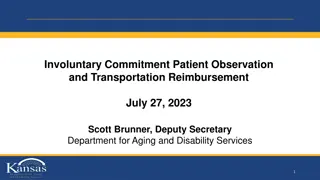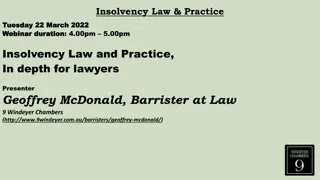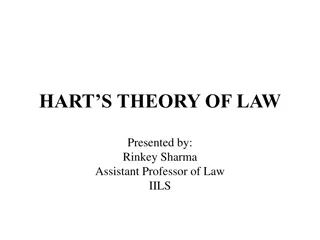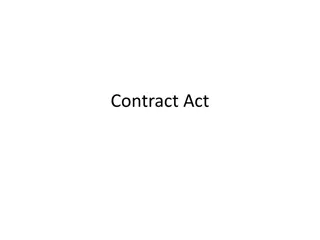Setting and Collecting Fees in Immigration Law
Becki Young and Jill Wayland from Hammond Young Immigration Law provide insights on setting fees for immigration cases, discussing hourly versus flat fees, reasons to charge each, and guidelines for setting flat fees for specific case types. They highlight the importance of transparency, efficiency, and client awareness in fee structures.
Download Presentation

Please find below an Image/Link to download the presentation.
The content on the website is provided AS IS for your information and personal use only. It may not be sold, licensed, or shared on other websites without obtaining consent from the author. Download presentation by click this link. If you encounter any issues during the download, it is possible that the publisher has removed the file from their server.
E N D
Presentation Transcript
Setting and Collecting Fees Presented by: Becki Young, Managing Partner and Jill Wayland, Director of Operations Hammond Young Immigration Law, LLC
Becki L. Young Becki L. Young, co-founder of Hammond Young Immigration Law, is a seasoned business immigration attorney with 20 years of experience in the field. Ms. Young facilitates the sponsorship of foreign professionals, trainees, interns and individuals of "extraordinary ability." She regularly provides immigration law advice to clients in a broad range of industries. Ms. Young is an active member of the American Immigration Lawyers Association (AILA). She frequently speaks at legal, business and hospitality conferences, and contributes insight through published articles and commentary. She is listed as a Noted Immigration Practitioner in Washington, DC by Chambers & Partners and recognized as a Leading Legal Practitioner in Corporate Immigration by US News & World Report / Best Lawyers and Who's Who Legal. Hammond Young Immigration Law LLC is rated Tier 1 National and Washington DC for Immigration Law by US News & World Report / Best Lawyers.
Jill Wayland Jill Wayland is the Director of Operations for Hammond Young Immigration Law, LLC and their sister firm, Grossman Law, LLC. She manages the Finance and Accounting, Marketing, IT and Human Resources functions for both firms. Prior to joining Hammond Young and Grossman Law, Ms. Wayland spent 7 years as the Director of Operations with Travelers Insurance and 13 years as the Risk Manager for US Foods. Ms. Wayland has extensive experience developing budgets, managing accounts payable/receivable functions, providing IT software training, administering insurance programs, and strengthening administrative and compliance programs.
Hourly Fees Flat Fees Agenda Staged (Payment Plans) Collections
Hourly vs. Flat Fee REASONS TO CHARGE HOURLY Insurance - If the matter takes longer to complete due to unforeseen circumstances or is more complex than originally determined, you will get paid for the additional time. Transparency The client can see exactly what work they are paying for on the invoice. Compensation Decisions More easily identify Associate realization. REASONS TO CHARGE A FLAT FEE Experience You know how much time it will take to handle a specific case type and how much you should charge to ensure you make a profit. Efficiency If you complete a case more quickly than estimated, the time you save equals profit. Client Awareness Clients have the peace of mind of knowing upfront exactly what they will spend. Simplicity Simplifies the billing process.
Setting Flat Fees Average Attorney Time (hours) Average Paralegal/Legal Writer Time (hours) 85% of Flat Fee Total Time Value (F+I) Average Hourly Rate Time Value (D*E) Average Hourly Rate Time Value (G*H) Matter Type O-1 Petition $8,000 $6,000 10 $300 $3,000 20 $150 $3,000 Our goal is to complete all flat fee cases at 85% of the flat fee. Inevitably, some cases will go over 100% of the flat fee so if we target 85%, then hopefully the average time spent for all cases will be about 100% of the flat fee.
Flat Fee Profitability Sum of Billable Fees 16,819 3,049 1,000 6,184 2,000 26,738 21,589 218,398 9,040 3,028 33,863 19,429 21,194 115,384 31,911 515 133,169 15,846 679,153 Sum of Actual Fees 14,819 2,550 1,000 9,000 5,567 25,773 19,219 284,629 10,500 3,140 60,000 19,250 27,675 136,168 25,435 165 138,692 17,040 800,621 Sum of Profitability (2,000) (499) 0 2,816 3,567 (965) (2,370) 66,231 1,460 112 26,137 (179) 6,481 20,785 (6,476) (350) 5,523 1,195 121,468 Use real case data to test assumptions. Test the impact of assumed volume on payroll and overhead. Identify direct costs separately. Develop capacity analysis. Develop frequency analysis. Matter Type AOS AOS derivative B-1 in lieu of H-1B E-2 E-3 EOS General H-1B H-3 H-4 or other NIV derivative I-130 & AOS I-140 & AOS L O-1 Petition other PERM RFE TN Grand Total
Staged Payments (Payment Plans) Benefits Builds the client relationship (compassion, trust). Helps to mitigate late payments. Downside Potential for completing work far in advance of when payments are due/received. Complicates the billing process. Alerts Create earning milestones. Require monthly payments vs. quarterly. Ensure monthly payment amounts will coincide with earning milestones.
Rep Agreement Payment Plan Sample The Client understands and agrees that the fees for the legal services described in the second paragraph of this Contract have a non-negotiable fee of $______ (the "Total Fee") and that it is calculated based on the law and the circumstances at the time the Contract is signed. The Client also understands and agrees to pay an "Initial Deposit," which represents a part of the Total Fee, to obtain the services of the Firm and for the Firm to start working on its case. The Initial Deposit is $_____ and must be paid at the time of signing this Agreement. For your benefit, the Initial Deposit will be deposited in a secure account. By court rules, your deposit will be part of a group of deposits and any interest generated by this group of deposits will be collected by the "Maryland Legal Services Corporation Fund." The Firm will subtract funds from this account as you have earned them. The Firm will consider the Initial Deposit won when the Lawsuit for Custody is ready to present to the Family Court. The Client understands and accepts that the remaining amount of the Total Fee for legal services must be paid as follows: twelve (12) payments of $_____ every month, with the first payment being September 1, 2017. The Firm will consider these payments earned in the following manner: $_____ when the Family Court schedules the hearing; $_____ having prepared the application for SIJS ready to submit to USCIS; and $_____ by having the application for Adjustment of Status ready to submit to USCIS.
Sample Representation Agreement It is also understood and agreed by the Client that the fee for legal services described in paragraph two above shall be a total fee of $X, (the Total Fee ) and that this fee is based upon the law and facts presented at the time of signing this Agreement. It is further understood and agreed that the Client will pay an Initial Deposit or a portion of the Total Fee, in order to retain the Firm and initiate work on the Client s case. An Initial Deposit of $__________ is due at the time of signing this Agreement. The Initial Deposit will be held in a trust account for your benefit. By court rule, it will be placed in a pooled account and any interest earned on the pooled account is payable to the Maryland Legal Services Corporation Fund. The Firm will deduct funds from that account as the funds are earned. The Initial Deposit will be deemed earned after the following event: _________________. The Client agrees that the remaining amounts of the Total Fee for legal services shall be paid as follows: $X upon _______________________, and $Y upon __________________________. As these subsequent payments are based upon legal services that the Firm has already performed, they will be deemed earned upon receipt.
Financial Management Software: Client Billing Software TimeSlips, TimeMatters, Clio, PracticePanther Billed vs Amount Paid Capture amount of time spent on matter Billing software must allow you to create a report of the unpaid balances and how long the balances have been outstanding Must send client, payment, and refund information to your Accounting Software e.g. Timeslips allocates payments for legal fees and expenses and sends this information to QuickBooks which simplifies tax preparation, budgeting, and tracking of your profit & loss
Keeping Track of Outstanding Payments Utilize Billing Software Create Accounts Receivable reports Determine receivables outstanding as of 30, 60, 90, 120 days Prioritize receivables Earned Work has already been completed (Priority) Retainer Work has not been started Realization Important for cash flow Collections Realization Rate - % of fees billed that you collect Billing Realization Rate - % of time worked on a matter that you actually bill to a client Accounts Receivable (AR) Turn-Over Ratio (Operating Income/Average AR) 365/turn-over ratio = Average # of days to be paid Annual Operating Income =$1,000,000 Average AR Balance = $400,000 AR Turn-Over Ratio = $1mm/$400,000 = 2.5% Average days to be paid = 365/2.5 = 146 days
How to Handle Clients Who Arent Paying Their Bills: Collections Procedure Review monthly outstanding accounts receivable balances Prioritize receivables Earned Retainer Call or e-mail all clients with a 31 day or greater balance due Track all collection activity Who did you call/e-mail Date of call/e-mail Person to person contact or did you leave a message Client response Identify next steps Write off balance Payment plan Collection Agency








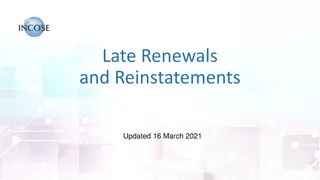



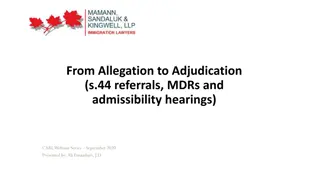


















![Town of [Town Name] Real Estate Tax Rates and FY 2024 Budget Summary](/thumb/62211/town-of-town-name-real-estate-tax-rates-and-fy-2024-budget-summary.jpg)



